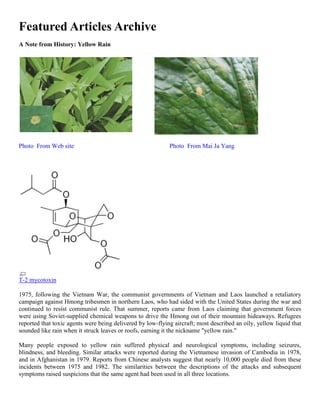
Burmese Army Chemical Weapon used ---Yellow Rain (acid rain) in Mai Ja Yang Photos (20-11-2011
- 1. Featured Articles Archive A Note from History: Yellow Rain Photo From Web site Photo From Mai Ja Yang T-2 mycotoxin 1975, following the Vietnam War, the communist governments of Vietnam and Laos launched a retaliatory campaign against Hmong tribesmen in northern Laos, who had sided with the United States during the war and continued to resist communist rule. That summer, reports came from Laos claiming that government forces were using Soviet-supplied chemical weapons to drive the Hmong out of their mountain hideaways. Refugees reported that toxic agents were being delivered by low-flying aircraft; most described an oily, yellow liquid that sounded like rain when it struck leaves or roofs, earning it the nickname "yellow rain." Many people exposed to yellow rain suffered physical and neurological symptoms, including seizures, blindness, and bleeding. Similar attacks were reported during the Vietnamese invasion of Cambodia in 1978, and in Afghanistan in 1979. Reports from Chinese analysts suggest that nearly 10,000 people died from these incidents between 1975 and 1982. The similarities between the descriptions of the attacks and subsequent symptoms raised suspicions that the same agent had been used in all three locations.
- 2. Initially, U.S. chemical weapons experts were baffled by yellow rain. The symptoms described by refugees did not match the effects of any known chemical weapon agent. However, in July 1981, a U.S. Army toxicologist noted a striking similarity between the symptoms of yellow rain exposure and those resulting from exposure to fungal toxins called trichothecene mycotoxins. Mycotoxins are naturally occurring substances produced by fungi, many of which can be harmful to animals and humans. Trichothecene mycotoxins comprise a group of more than 40 compounds found in common grain mold. Laboratory analysis of a yellow rain sample taken from an alleged attack site in Laos identified three different trichothecenes present in concentrations and combinations not known to occur in nature. Trichothecene mycotoxins are believed to have been discovered accidentally by the Soviet military during World War II. During that time, thousands of Soviet civilians were afflicted with alimentary toxic aleukia, a highly lethal disease with symptoms resembling radiation poisoning. The disease was caused by the ingestion of bread made with flour contaminated by fusarium mold, which had grown on wheat left in fields all winter long, due to the war. This outbreak spurred intensive Soviet research on mycotoxin poisoning as a public health threat. The Soviet Union also had some manner of ties to each of the locations where yellow rain had been reported: the Soviets supported the Communist Vietnamese forces and the Pathet Lao political movement in Laos and Cambodia, and were directly involved in the war in Afghanistan. U.S. intelligence hypothesized that the Soviets had recognized the military potential of trichothecenes and developed them as weapons. In 1981, based on this hypothesis and the laboratory findings, then U.S. Secretary of State Alexander Haig announced that physical evidence had been found, proving that mycotoxins supplied by the Soviet Union were being used as a weapon against civilians and insurgents in Southeast Asia and Afghanistan. The U. S. allegation was not universally accepted. Some nations were unsuccessful in identifying mycotoxins in yellow rain samples, and the United Nations found the evidence to be inconclusive. In 1987, a group of academic scientists, led by Harvard molecular biologist Matthew Meselson, traveled to Laos to conduct an investigation. The team noted that some trichothecene mycotoxins occurred naturally in the region. Based on this and the presence of pollen in some yellow rain samples, the team offered an alternative hypothesis that the yellow rain phenomenon was not a chemical attack, but the result of massive swarms of bees depositing feces over the areas. Such swarms have been documented before and since the yellow rain incidents—although mass casualties did not result from these swarms. An example of one such swarm occurred in India in 2002. This incident is cited by proponents of the bee feces hypothesis as supporting evidence. At that time, a yellow-green rain fell from the sky on the town of Sangrampur, near Calcutta. Fears arose that the rain might be contaminated with toxins or chemical warfare agents, but scientists confirmed that the yellow-green droplets were, in fact, bee feces containing pollen from local mangoes and coconuts. The scientists concluded that the colored rain could have been caused by the migration of a giant swarm of Asian honeybees. The U.S. government has never retracted the yellow rain allegations, and the controversy has never been fully resolved. A declassified CIA intelligence document written in 1983, suggests that the Soviet Union developed weapons based on trichothecene mycotoxins as early as 1941 and may have tested them on political prisoners. The Soviet Union never declared any stockpiles of trichothecene mycotoxins among their stores of chemical and biological weapons, however, and no trace of a trichothecene-containing weapon was ever found in the areas affected by yellow rain. Their use may never be unequivocally proved.
- 3. Photos from Mai Ja Yang